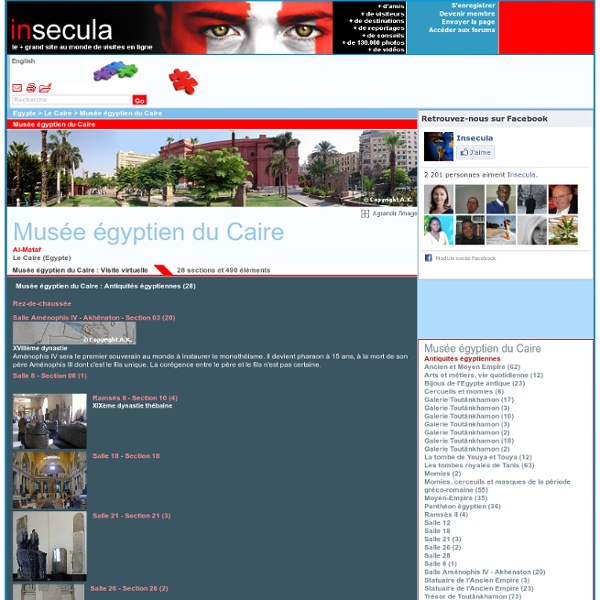



Cairo Egyptian Museum The Egyptian Museum in Cairo contains the world's most extensive collection of pharaonic antiquities; no visit to Egypt is complete without a trip through its galleries. The original collection was established in the late 19th century under Auguste Mariette and housed in Boulaq. The objects were moved in 1891 to the palace of Ismail Pasha in Giza before being transferred in 1902 to the current building at Tahrir Square, which is the first purpose-built museum edifice in the world. Designed in the Neoclassical style by Marcel Dourgnon, the Egyptian Museum boasts 107 halls filled with artifacts dating from the prehistoric through the Roman periods, with the majority of the collection focused on the pharaonic era. Labels are in Arabic and English HOURS OF OPERATION: Open daily, 9:00 AM-7:00 PM 9:00 AM-5:00 PM during Ramadan LOCATION: Midan al-Tahrir, Downtown Cairo DIRECTIONS: By metro: Sadat Station, follow signs to Egyptian Museum exit and walk straight along the street.
Wikipedia The Museum of Egyptian Antiquities, known commonly as the Egyptian Museum or Museum of Cairo, in Cairo, Egypt, is home to an extensive collection of ancient Egyptian antiquities. It has 120,000 items, with a representative amount on display, the remainder in storerooms. History[edit] The Egyptian Museum of Antiquities contains many important pieces of ancient Egyptian history. It houses the world’s largest collection of Pharaonic antiquities, and many treasures of King Tutankhamen. A new museum was established at Boulaq in 1858 in a former warehouse, following the foundation of the new Antiquities Department under the direction of Auguste Mariette. During the Egyptian Revolution of 2011, the museum was broken into, and two mummies were reportedly destroyed.[1][2] Several artifacts were also shown to have been damaged.[3] Around 50 objects were lost.[4] Since then 25 objects have been found. Interior design[edit] Gallery[edit] See also[edit] References[edit] Further reading[edit]
Grand Egyptian Museum The Grand Egyptian Museum (GEM), also known as the Giza Museum, is a planned museum of artifacts of ancient Egypt. Described as the largest archaeological museum in the world,[4] the museum is scheduled to open in 2015. The museum will be sited on 50 hectares (120 acres) of land approximately two kilometers from the Giza pyramids and is part of a new master plan for the plateau. Overview[edit] The design of the building was decided by means of an architectural competition. The competition was announced on 7 January 2002. The total estimated project cost is US$ 550m, US$ 300m of which will be financed from Japanese loans, the remaining will be financed by the Supreme Council of Antiquities, other donations and international funds. The new museum is designed to include the latest technology, including virtual reality. Progress[edit] On 5 January 2002 then-Egyptian President Hosni Mubarak laid the foundation stone of the Grand Egyptian Museum. See also[edit] References[edit] Coordinates:
JICA-GEM Peng's design Grand Egyptian Museum Cairo, Building, Egyptian Project, Architect, Images, Design Cairo Architecture, Egypt by heneghan.peng.architects Project Description THE SITE: Between the Modern Complexities of Cairo and the Ancient Culture of the Pyramids Model photo photo : Richard Davies Three significant elements organise the New Museum within the site: • The Plateau Edge, which divides the site into higher and lower sections Exterior Night rendering image : Archimation ARCHITECTURAL PROPOSAL: Architecturalizing the Face of the Plateau The proposal for the Grand Egyptian Museum begins by forming a new ‘edge’ to the Plateau, by creating a gentle slope as a thin veil of translucent stone structured by fractal geometry; opening and closing like foldings within the desert sand. Exterior Day rendering BETWEEN THE SPACE OF THE PYRAMIDS: Relationship between the Museum and the Pyramids LOOKING TO CAIRO: Relationship between the Museum and Cairo image : heneghan.peng.architects Heneghan Peng Map Data Map
Notice des principaux monuments Construit par ordre du Khédive Ismaïl, le palais de Gizeh fut affecté au service des antiquités en 1890, et M. E. Grébaut, alors directeur général des Musées et des fouilles, y fit apporter de Boulaq les monuments qui pendant trente années avaient été réunis dans un Musée provisoire par les soins de A. Mariette, de M. G. Maspero et de M. qui s'opposaient alors à la construction d'un musée neuf sur la rive droite du Nil, décida que la somptueuse demeure d'Ismaïl deviendrait le Palais des antiquités égyptiennes. Quelque mal appropriée qu'elle soit à l'usage auquel elle est aujourd'hui consacrée, cette vaste construction a permis d'exposer toutes les collections, et les quatre-vingt-onze salles, dont quarante-six viennent d'être récemment ouvertes, permettent au public et aux savants d'admirer et d'étudier les restes de cette civilisation prodigieusement antique et sans rivale. S. le plus vaste et le plus riche du monde. M. Le hasard le rejeta du côté de l'Orient.
Notice des principaux monuments exposés au Musée de Gizeh Construit par ordre du Khédive Ismaïl, le palais de Gizeh fut affecté au service des antiquités en 1890, et M. E. Grébaut, alors directeur général des Musées et des fouilles, y fit apporter de Boulaq les monuments qui pendant trente années avaient été réunis dans un Musée provisoire par les soins de A. Mariette, de M. G. qui s'opposaient alors à la construction d'un musée neuf sur la rive droite du Nil, décida que la somptueuse demeure d'Ismaïl deviendrait le Palais des antiquités égyptiennes. Quelque mal appropriée qu'elle soit à l'usage auquel elle est aujourd'hui consacrée, cette vaste construction a permis d'exposer toutes les collections, et les quatre-vingt-onze salles, dont quarante-six viennent d'être récemment ouvertes, permettent au public et aux savants d'admirer et d'étudier les restes de cette civilisation prodigieusement antique et sans rivale. S. le plus vaste et le plus riche du monde. M. Mariette (Auguste-Ferdinand) naquit à Boulogne-sur-Mer le 11 février 1821.
The Egyptian Museum in Cairo